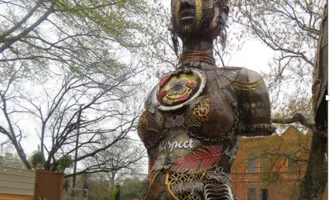
One of the unwitting human test subjects of the Tuskegee Syphilis Study.
Courtesy of the CDC.
This Date in UCSF History: Whistleblower Describes Tragic ‘Study’
Originally published in Synapse on January 20, 1994.
The 40-year study of untreated syphilis in black men at the Tuskegee Institute, a project which has received extensive moral condemnation and has irrevocably destroyed the faith of many in the American medical system, has taken on a renewed significance in light of current revelations concerning experiments exploring human exposure to radiation during the Cold War.
In a Jan. 12 talk at UCSF, Peter Buxton, the man whose efforts brought the Tuskegee study to national attention, explained its evolution and final unraveling.
Tuskegee, which is the county seat of Macon, Alabama, shared the impoverished and undeveloped characteristics of much of the rural South at the turn of the century.
Its population consisted primarily of black sharecroppers, most of whom lived in ramshackle huts, were malnourished, and were frequency infected with malaria and parasitic worms.
The preponderance of impure water and the sharecroppers’ almost complete lack of medical resources made the spread of disease common.
In addition, much of the black population was illiterate and uneducated, due to Alabama’s minuscule educational expenditures.
In 1930 the National Health Service initiated a program to use the Wassermann syphilis antibody test to detect the syphilis spirochete, and to treat infected subjects with salversan, considered the “magic bullet” which eradicate the disease.
Tuskegee was chosen as one site for the syphilis control programs due to the high incidence of the disease in the area. From 1930 to 1932, the program tested and treated individuals for syphilis, finding an infection rate of 195 per thousand individuals, compared to a national rate of four per thousand.
In 1932, in the midst of the Great Depression, government funding for the program dried up, and the foundations which had endowed the program also cut off their contributions. The program was revived in a new form, however, due to the efforts of Talliafero Clark, a white physician with the Centers for Disease Control (CDC), who was interested in studying untreated syphilis in black men to see if the disease ran a different course than it did in whites.
Clark was unable to receive public funding but was eventually endowed by the Tuskegee Health Institute.
The Tuskegee Institute had been founded in 1881 by Booker T. Washington and was the site of George Washington Carver’s landmark experiments in peanut cultivation.
Entitled “Untreated Syphilis in the Male Negro,” the study allowed its subjects to suffer the full range of neurological disorders associated with syphilis — including blindness and psychosis — even after cheap, standard treatments with penicillin were made available in 1945.
The participants were not informed that they were the subjects of an experiment and were often misled into believing that they were receiving medication.
The eagerness of local blacks to receive medical attention, their deference to the better educated doctors, and the provision of food lured many individuals to become the unwitting subjects of an inhuman experiment.
It was in 1966 that Peter Buxton, then a syphilis investigator for the Public Health Service in San Francisco, first became aware of the existence of the Tuskegee study, and of its program of withholding proper medical treatment from its subjects.
Buxton, who is white, wrote to the CDC in Atlanta requesting records of the study. The CDC readily sent these records, which described the higher mortality and morbidity rates seen in the untreated patients, but which claimed the subjects were volunteers.
Outraged, Buxton sent a personal report to the Health Institute in which he compared the Tuskegee study to the brutal experimentation performed by Nazi doctors.
For the next three years, the CDC defended the validity of the study to Buxton and warned that any publicity concerning the study would heighten the racial tensions that had flared into urban rioting in the mid-1960s.
Buxton, who had entered Hastings Law School, could not persuade any lawyers with whom he had contact to pursue the Tuskegee case. Buxton was unable to generate any publicity concerning Tuskegee until 1972, when he persuaded an Associated Press reporter to break the story.
The revelation of the study led to a Congressional investigation, and Buxton was called to testify, even though he himself had never visited Tuskegee.
The investigation took place as the Watergate scandal was developing, so the Tuskegee case was largely overshadowed in the press.
Finally, in response to Congressional and public pressure, the study was terminated. None of the 600 subjects were given any legal redress or financial compensation for their sufferings.
Much of the outrage over the Tuskegee study has been directed towards Sidney Olansky, MD, an investigator who continued to claim the study was important even after it was discontinued.
Perhaps the most tragic figure in the study, according to Buxton, was Eunice Rivers, a black nurse who helped obtain subjects and acted as a liaison between them and the doctors. Her motives have never been fully understood, Buxton said.
The Tuskegee study was inherently racist, according to Buxton, since doctors were willing to sacrifice the health and well-being of their exclusively black subjects in order to advance their own interests and reputations.
Buxton pointed out, however, that black doctors were also involved. According to Buxton, the Tuskegee study broke the faith of many individuals — particularly African Americans — in the validity of medical institutions.
The Tuskegee case is a clear example of collaboration by the medical and political establishments in pursuit of a self-serving program in flagrant violation of universally accepted individual rights and moral principles.



